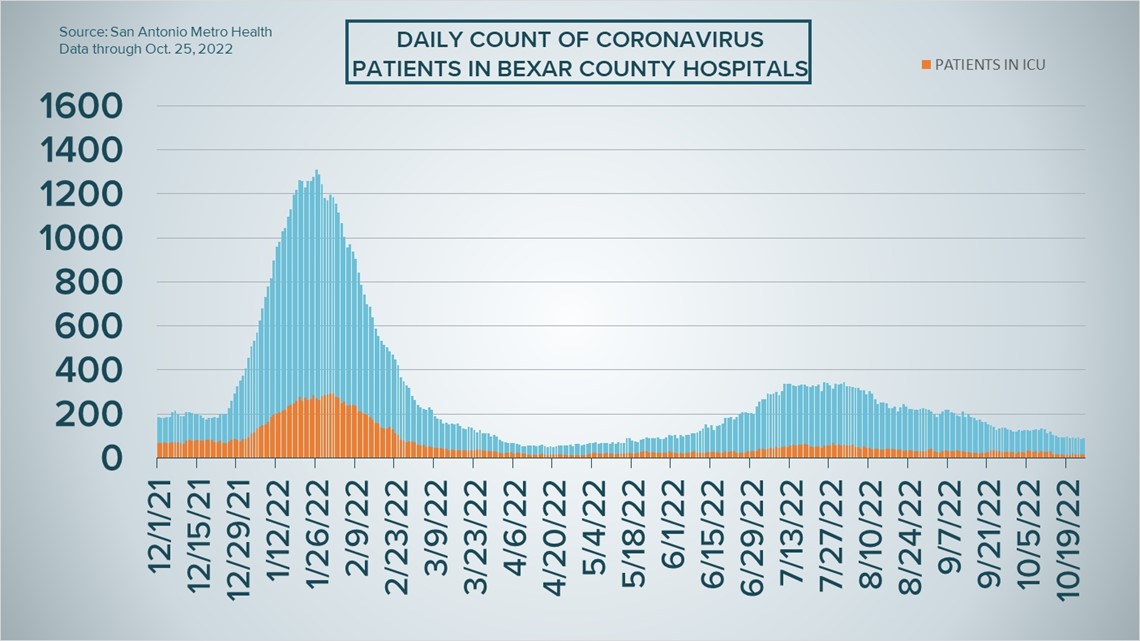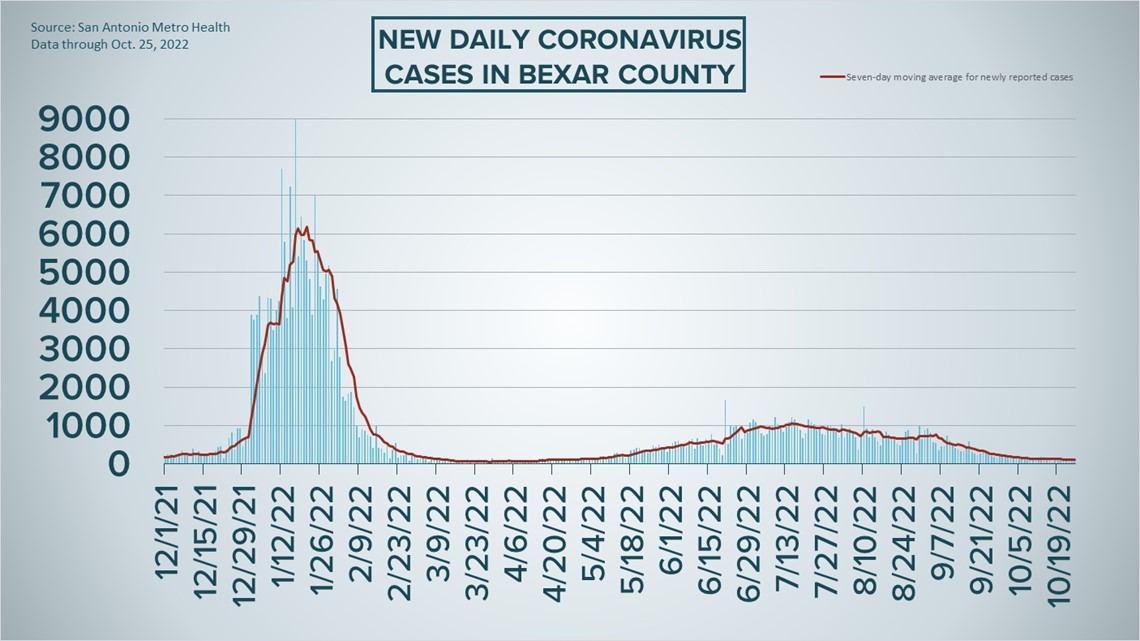SAN ANTONIO — The seven-day average for new COVID-19 cases is down to its lowest levels since mid-April and hospitalizations continue tumbling from a summertime surge as colder weather arrives in San Antonio.
Metro Health on Tuesday reported a single-day tally of 67 new infections. Aside from Oct. 17, when just 42 new cases were reported, that's the lowest count since April 12. October has brought an average of 126 new cases a day in San Antonio, nearly one-fourth of the 414 daily cases September yielded and down from 735 a day two months ago.
Hospitalizations also continue to fall; though they increased slightly on Tuesday, to 89, the number of local coronavirus patients receiving treatment in Bexar County hospitals is down by 25% since Oct. 1, and by 58% since Sept. 1.
Of the 89 hospitalized patients on Tuesday, 15 were in intensive care and three were using ventilators to help them breathe.
Metro Health is continuing to hold pop-up sites for COVID-19 vaccinations of all kinds. Find more info here or below:
Since the start of the pandemic, more than 647,000 cases have been reported in the San Antonio area (though the number is likely thousands more, taking into account at-home tests that went unreported) while 5,418 local residents have died from virus complications.
How Bexar County is trending




Vaccine progress in Bexar County
The following numbers are provided by San Antonio Metro Health. A full breakdown can be found here.
- 1,481,332 eligible Bexar County residents are fully vaccinated as of Oct. 10, which is about 73.9% of the total population over 6 months old.
- 591,339 eligible Bexar County residents have received a COVID-19 booster shot as of Oct. 10, which is 39.7% percent of the population over 4 years old.
The CDC states that "when a high percentage of the community is immune to a disease (through vaccination and/or prior illness)," that community will have reached herd immunity, "making the spread of this disease from person to person unlikely."
The City of San Antonio breaks down the vaccination rates by zip code on Metro Health's Vaccination Statistics page.
Coronavirus in Texas
The total number of coronavirus cases in the state grew by 1,079 on Monday, according to the Texas Department of State Health Services. That total includes 640 new confirmed cases and 439 new probable cases. More details can be found on this page.
Monday's figures bring the total number of Texans diagnosed with COVID-19 to more than 7.91 million.
Meanwhile, one more Texan has died from virus complications, the state reported Monday, raising the statewide death toll to 89,531. The latest daily figures, for Tuesday, weren't yet released by state officials.
Coronavirus symptoms
The symptoms of coronavirus can be similar to the flu or a bad cold. Symptoms include fever or chills, cough, shortness of breath or difficulty breathing, fatigue, muscle or body aches, headache, new loss of taste or smell sore throat, congestion or runny nose, nausea or vomiting, and diarrhea, according to the Centers for Disease Control.
Most healthy people will have mild symptoms. A study of more than 72,000 patients by the Centers for Disease Control in China showed 80 percent of the cases there were mild.
But infections can cause pneumonia, severe acute respiratory syndrome, kidney failure, and even death, according to the World Health Organization. Older people with underlying health conditions are most at risk.
Experts determined there was consistent evidence these conditions increase a person's risk, regardless of age:
- Chronic kidney disease
- COPD (chronic obstructive pulmonary disease)
- Obesity (BMI of 30 or higher)
- Immunocompromised state (weakened immune system) from solid organ transplant
- Serious heart conditions, such as heart failure, coronary artery disease, or cardiomyopathies
- Sickle cell disease
- Type 2 diabetes
- The CDC believes symptoms may appear anywhere from two to 14 days after being exposed.
Human coronaviruses are usually spread...
- Between people who are in close contact with one another (within about 6 feet).
- Through respiratory droplets produced when an infected person coughs, sneezes or talks. These droplets can land in the mouths or noses of people who are nearby or possibly be inhaled into the lungs.
- Some recent studies have suggested that COVID-19 may be spread by people who are not showing symptoms.
Help stop the spread of coronavirus
- Stay home when you are sick.
- Eat and sleep separately from your family members
- Use different utensils and dishes
- Cover your cough or sneeze with your arm, not your hand.
- If you use a tissue, throw it in the trash.
Find a testing location
City officials recommend getting a COVID-19 test if you experience fever or chills, cough, shortness of breath or difficulty breathing, fatigue, muscle or body aches, headache, new loss of taste or smell, sore throat, congestion or runny nose, nausea or vomiting, or diarrhea.
Here's a Testing Sites Locator to help you find the testing location closest to you in San Antonio.
Latest Coronavirus Headlines
- COVID Tracker: Bexar County hospitalizations back under 100 for the first time since June
- Biden receives updated COVID-19 booster shot, promotes vaccine
- Test scores show historic COVID setbacks for kids across US
- COVID Tracker: San Antonio cases down by nearly a third in October compared to month prior
- CDC panel unanimously votes to add COVID shots to recommended vaccines
- Pfizer says COVID-19 vaccine will cost $110-$130 per dose
- Report: COVID exacerbating maternal mortality crisis in US
- Hundreds attend first night of Greek Festival after a year off due to COVID pandemic

